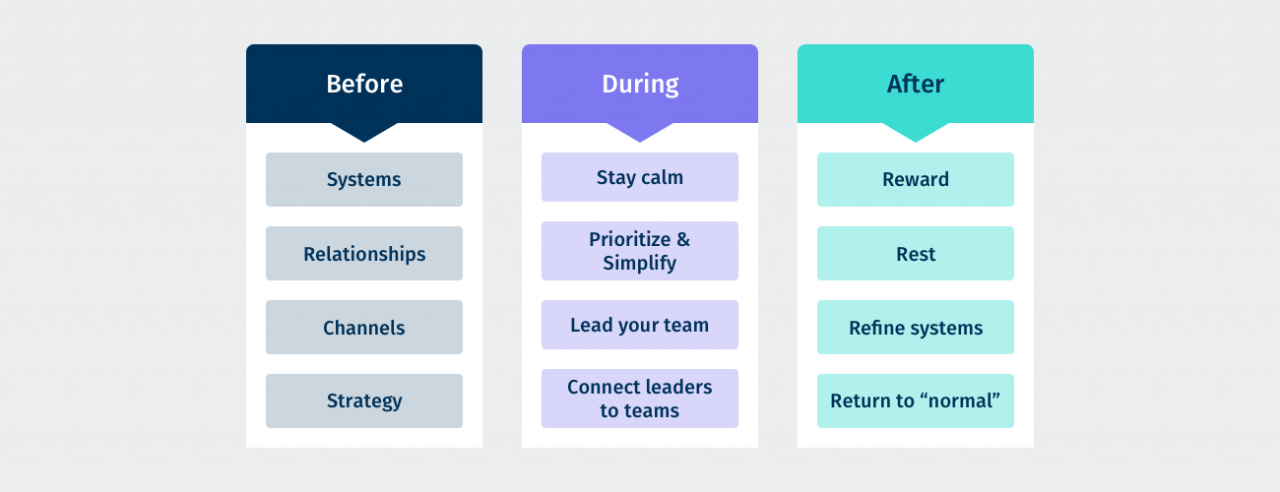Three Key Communication Lessons for Managing a Crisis
By
— November 4th, 2019

If you are in the middle of a crisis, please stop reading this blog and come back to it later...but by all means, keep going through your current crisis although you may feel like doing otherwise.
Everyone else, please keep reading because it’s only a matter of time before you’re facing a major event that needs your direction, focus, and determination…especially if you are in employee communications.
Business acumen in internal communications - why it matters and how to build it
Back in 2016, I joined an astoundingly successful, century-old Atlanta company that was approaching 40 quarters of beating Wall Street expectations. Less than a year later, that company was shaken nearly off its foundations by one of the worst business crises of this century.
You may have read about this in the papers. I think word got out.
While employees all over the world worked hard to remediate the problems, our internal communications team had a chance to help employees understand what was happening, and why, and how everyone could help lend a hand. Along the way, I was able to confirm or refine theories and practices developed throughout my military and civilian experience.
A lot of what I learned came from leading troops in combat, where questions of communication, meaning, and crisis take on a whole new meaning…and have a way of focusing the mind.
Before I get into three lessons learned, here’s a philosophical bottom line: The readiness is all. Wherever we are in our careers, whether we lead teams or can develop crisis plans...or we’re simply the English Major in the Room, watching leaders react to something awful while we await instructions...we internal communicators have the professional responsibility to get ready for crisis, which is when our leadership will be needed most.
And we will better rise to that challenge if we are continuously preparing, always watching how we and others respond to events beyond our control. Numbers don’t have crises: People do.
Lesson One: Demystify the experience
We’re scared of the unknown, and we’re rightfully scared of an event that could derail our plans, or end our company, or put us in a position where everyone’s success rests on our expertise.
A crisis unfolds like something monstrous and unreal; it stretches to the horizon and obscures our future. Shock at the scale alone can paralyze even the most seasoned operator.
I find it helps to confront this looming beast not by imagining it to be less than it is, but rather as something familiar made unfamiliar by its scale and speed.
Whether you call it growth, change, or life, almost everything we confront today is different in some way from what it was the day or week before. We have to adjust, but we’re used to it. So while we tell ourselves Change is Constant and argue that Today’s World is Changing Faster than Ever, we’re mostly fine and our systems and processes mostly account for this constant just as airplanes account for drag.
Yet take that same amount of change - say two leadership moves that would normally occur in a year - and squeeze them into a quarter. The events feel like a bigger deal because they take place over less time, and together they build a kind of momentum in our uncertainty that quickly turns into disruption. The old ways have been upended; new variables mean we can’t see as far into the future, and having that horizon pulled in makes us nervous.
Now make those two major leadership changes in the same day or week and what should be a relatively natural course of business is (or feels like) a crisis. The speed of the events, the mass of the change, together build an energy that hits us harder and makes us feel less in control, less able to handle what we’re seeing. We can only grasp so much; we’re afraid we’ll miss something; we’re forced to move faster than we like.
But take away the mystery. Crisis is the same amount of change, compressed into a tighter timeline. You’ve dealt with it before. In a crisis, we don’t have to reinvent the wheel or throw out what we’ve learned. Rather, we must prioritize efforts to account for fewer resources and clarify messages to account for the stress everyone else is feeling.
We need to do what we’ve always done but faster or by skipping some steps (e.g., research) that take too long or are areas where we can accept some risk (e.g. by relying more on experience or intuition).
If we can’t scale our processes and systems according to the resources we have, they’re not tight enough.
Lesson Two: Process helps bring order to chaos
Pilots, firefighters, and soldiers all face crisis by following checklists that force a systematic response to what might otherwise be a purely emotional event. Emotions override “normal” actions. We should make as many decisions as practical before we are bathed in very natural feelings that will change our responses (or make us freeze, costing us more time).
So here’s a set of priorities for dealing with a crisis, broken into three different phases: Before, During, and After.

Before the crisis occurs, we have to emplace systems that help us operate. Meetings, reports, metrics, press release formats, intranet story lengths, phone trees, approvals...these are all systems that define how we interact with each other. Familiar systems run faster.
Building relationships not just with others on the team, but with crisis partners (e.g., Legal, HR, IT, Security) take time no one will have once a crisis hits.
Channels include how to notify employees, as well as how to update them, which are distinct enough to consider separately.
Any good strategy will include a purpose that can apply to a crisis, or at least help us prioritize our efforts when time is short. If we’re not strategic on a sunny Monday in May, how can we be holistically brilliant when the September storm hits?
Duringa crisis, we will do our best work if we can stay calm. If we act with (at least external) deliberateness that doesn’t ignore emotion so much as channel it, we can have a tremendous effect on those around us. Because there is less time, we absolutely must prioritize and simplify communications or else confusion will degrade everyone further.
Prioritization is one of the single best ways to lead your team, and we can do it whether explicitly because we’re in charge, or implicitly by our example.
Finally, our regular duty to connect leaders to teams is essential to weathering a crisis. Teams need their leaders and we should find ways to help them connect. More on this below.
After a crisis, the Tyranny of Now reasserts itself. It’s easy to be drawn back into the next big thing, and in so doing lurch from crisis to crisis. We should be as systematic coming out of a crisis as we are during one. First, we should reward behaviors and accomplishments we want to see again. Make it public and make it real; be explicit.
Rest always seems to be fleeting, doesn’t it? We can even be so high on post-crisis success that we think we don’t need it! It takes discipline to rest, and wisdom to know when is the right time, but we simply must make time because another crisis will come, and we don’t want to enter it exhausted. We also need to take the gaps between crises to refine our systems, applying lessons learned to improve how we operate.
Finally, we need to drive a return to “normal” that gets us out of crisis mode. Ceaseless crises wear people down, sap morale, and distract us with constant emergency behaviors. No one likes staying on the defensive!
Treating a crisis as something with a beginning, middle, and end helps us see the story we need to tell to help others make sense of it.
Lesson Three: Leaders are people, too
There’s a section of Gen. Patton’s autobiography titled “Earning My Pay,” where he chronicles instances where he made a personal difference in trying circumstances. He was successful in part because early in his career he recognized that he would be under fire, and affected by fear and doubt; so he trained himself early to ignore his own peril, or more accurately to get comfortable with it, so he could focus on the mission and his troops.
Keep in mind that leaders are also in crisis, although they often experience the crisis differently from almost everyone else. This is especially true if they’re personally called out as a cause of the crisis.
Many will exhibit stress behaviors, maybe doing things completely out of character. That’s OK. Being patient with this can really help us counsel them, as well as help our team react more calmly. Folks won’t need more stress, which is a fire that will consume everything you feed it.
Leaders may also have known about the issue longer. Once the leader has come to grips with the crisis, they may be out of alignment with their teams. Some leaders will think that’s old news, and nothing more need be said.
Or if they’ve had time to rationalize a problem, it may not loom as large as it does to everyone else. That can be useful. But it can also cause tone-deaf communications or, worse, increase uncertainty.
I’ve seen this both in peace and in war, and often the impulse comes from a good place, an intent to “shield” teams so they can stay focused. Good leaders balance this against the need for trust and transparency; good communicators help them do it better.
There are a lot of things that will separate leaders from teams during a crisis. “I’ll get to it” or “the time isn’t right” or “we don’t know what to say” are all common, and valid, responses. As internal communicators, we should make it easier for leaders to reach their teams, who need them.
A good example is the town hall or conference call. While we might normally craft talking points for such an event, what if things are moving so fast that only the leader can really determine what can be said? When I can’t specify their talking points, I like to follow this arc to help them get comfortable enough to share the right things:
- Empathize. Be human and understanding.
- Update. Paint a common operating picture.
- Explain something tricky. Build trust by trusting them.
- Inspire. We can do this, together.
Give leaders the buckets and let them fill them up. People seem to respond really well to this story arc. We all want leaders to be calm and in control; having a pattern for them to follow frees them up and lets them be more comfortable. It lets them be human, which is vital to securing the trust necessary to shepherd employees through the crisis.
When people are in a crisis, give them a reasonable expectation of a positive future.
Conclusion: Keep going!
Stress, doubt, fear, and uncertainty all make us want to stop; they drain our confidence, sap our energy, even justify inaction. While we shouldn’t be reckless, organizations must maintain inertia because it takes a lot of energy to get people moving again...and that’s energy best used solving the problems at hand.
Organizations are depending on internal communicators to prepare personally for crisis, build scalable systems, and help leaders lead their teams.
That’s when we truly get to shine.









